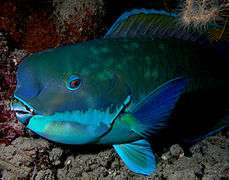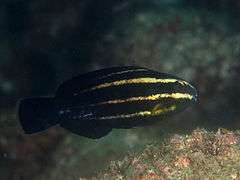Chlorurus microrhinos
| Chlorurus microrhinos | |
|---|---|
| | |
| Male of Chlorurus microrhinos from French Polynesia | |
| Scientific classification | |
| Kingdom: | Animalia |
| Phylum: | Chordata |
| Class: | Actinopterygii |
| Order: | Perciformes |
| Family: | Scaridae |
| Genus: | Chlorurus (Swainson, 1839)[2] |
| Species: | C. microrhinos |
| Binomial name | |
| Chlorurus microrhinos (Bleeker, 1854) [3] | |
| Synonyms | |
|
Callyodon microrhinus (Bleeker, 1854) | |
Chlorurus microrhinos, the blunt-head parrotfish or steephead parrotfish , is a member of the family Scaridae. [4]
Distribution
This species is one of the most widespread. It is present in the extreme east Indian Ocean and in the Pacific Ocean, from the Ryukyu and Ogasawara Islands to Indonesia and Australian Great Barrier Reef, Lord Howe Island, New Caledonia and French Polynesia, and eastwards to Oceania (Hawaii and Easter Island excluded).[1]
Habitat
Blunt-head parrotfishes can be found in many different habitats, including lagoon, inshore reefs and ocean reef fronts, from 2 to 50 m. At Guam, large individuals are seldom seen in shallow water [1]
Description

Chlorurus microrhinos usually grows to be about 80 centimetres (31 in) long. These parrotfishes are greenish blue, with a brilliant blue band behind the corner of the mouth and a wide blue patch along the head. Rarely some individuals may be uniformly yellowish-tan. The cheek is crossed by an irregular line, below which the colour is usually greenish-yellow. Larger fishes are uniformly dark, greenish brown, turning into greenish blue only with age, but they do not undergo as radical a color change with growth as do other scarids.
They have nine dorsal spines, 10 dorsal soft rays, 3 anal spines and 9 anal soft ray. The tail is crescent shaped in large terminal males, while in juveniles is rounded. Adults show large exposed blue-green tooth plates, with one or two canines on each side of the upper plate. [5]
Large males develop a prominent forehead (hence the common name of blunt-head parrotfishes). Juveniles are black with some horizontal white stripes. [6]
Some geographic variation exists between Red Sea, Western Indian Ocean, and Pacific populations, and an unusual reddish-tan phase occurs in the central Pacific.[7]

Biology
These parrotfishes mainly feed on benthic algae and material scraped from corals leaving exposed reef substrate. They grows rapidly and can reach an age of about 15 years. They usually swim in schools of about 40 fish. Juveniles are generally solitary. Adults may be slightly toxic at some Pacific localities [1]
Bibliography
- Bellwood, D.R. 2001: Family Scaridae. A: Carpenter & Niem 2001. Species identification guide for fishery purposes. Bony fishes part 4. 6: 3468-3492, Pls. VI-XIV.
- Bleeker, P. 1854: Speciés piscium bataviensium novae vel minus cognitae. Natuurkundig Tijdschrift voor Nederlandsch Indië, 6: 191-202.
- Helfman, G., B. Collette i D. Facey: The diversity of fishes. Blackwell Science, Malden, Massachusetts (USA), 1997.
- Moyle, P. i J. Cech.: Fishes: An Introduction to Ichthyology, 4a edició, Upper Saddle River (Nova Jersey, Estats Units): Prentice-Hall..
- Nelson, J.: Fishes of the World, 3rd ed.. New York: John Wiley and Sons.
- Parenti, P. I J.E. Randall. An annotated checklist of the species of the labroid fish families Labridae and Scaridae. Ichthyol. Bull. J.L.B. Smith Inst. Ichthyol. (68):1-97.
- Randall, J.E., 1986. Scaridae. p. 706-714. A M.M. Smith i P.C. Heemstra (eds.) Smiths' sea fishes. Springer-Verlag.
- Wheeler, A.: The World Encyclopedia of Fishes, 2nd ed.: Macdonald.
References
- 1 2 3 4 IUCN
- ↑ Swainson W. 1839. The natural history and classification of fishes, amphibians, & reptiles, or monocardian animals. London. Nat. Hist. & Class. v. 2. i-vi + 1-448.
- ↑ Marine Species
- ↑ Biolib
- ↑ Australian Museum
- ↑ OZ Animals - Australian Wildlife
- ↑ Amesbury, S.S. and Myers, R.F., Scaridae(Parrotfishes). Retrieved 23rd, 2014 from: Guam Marine Lab
